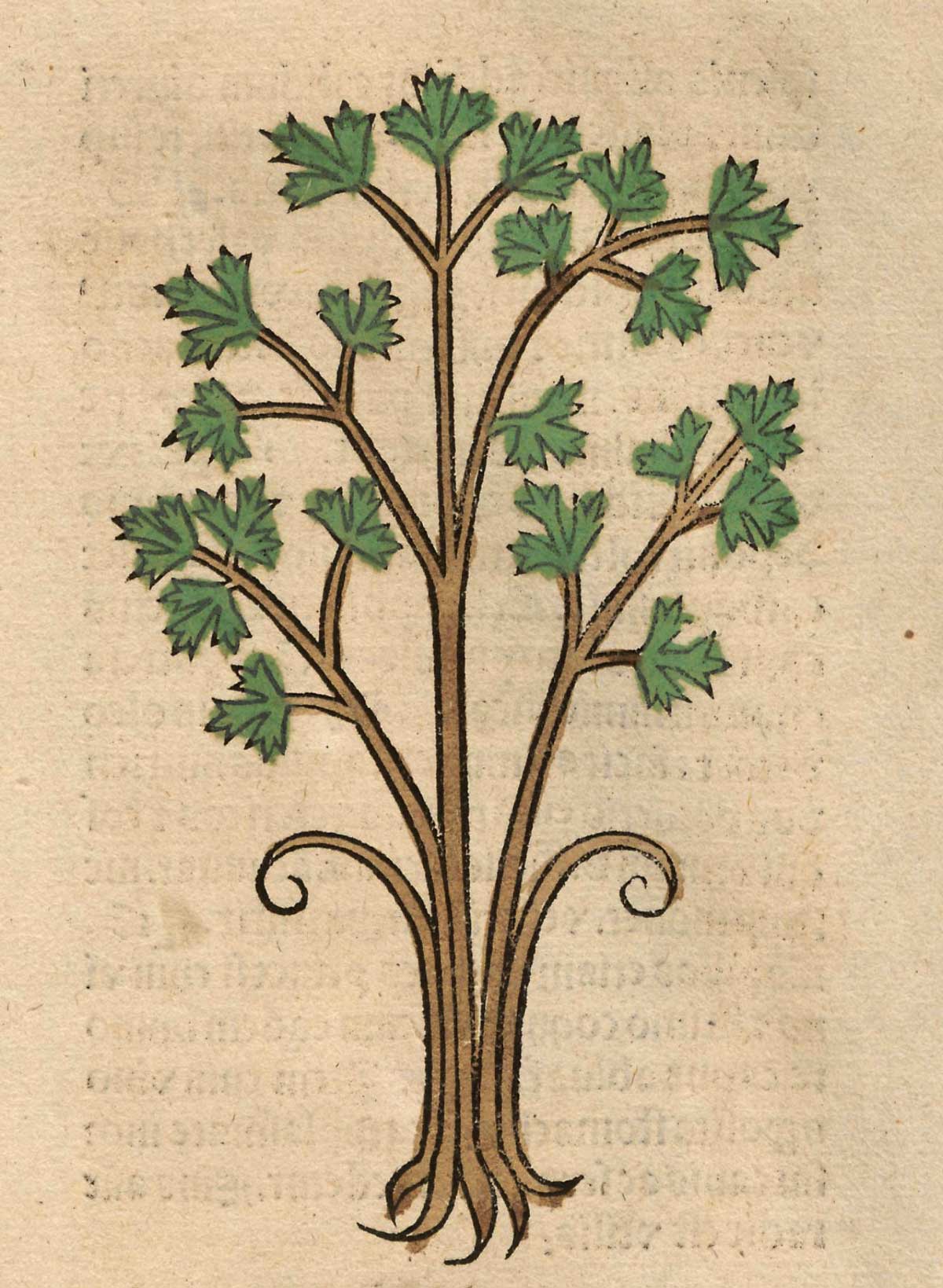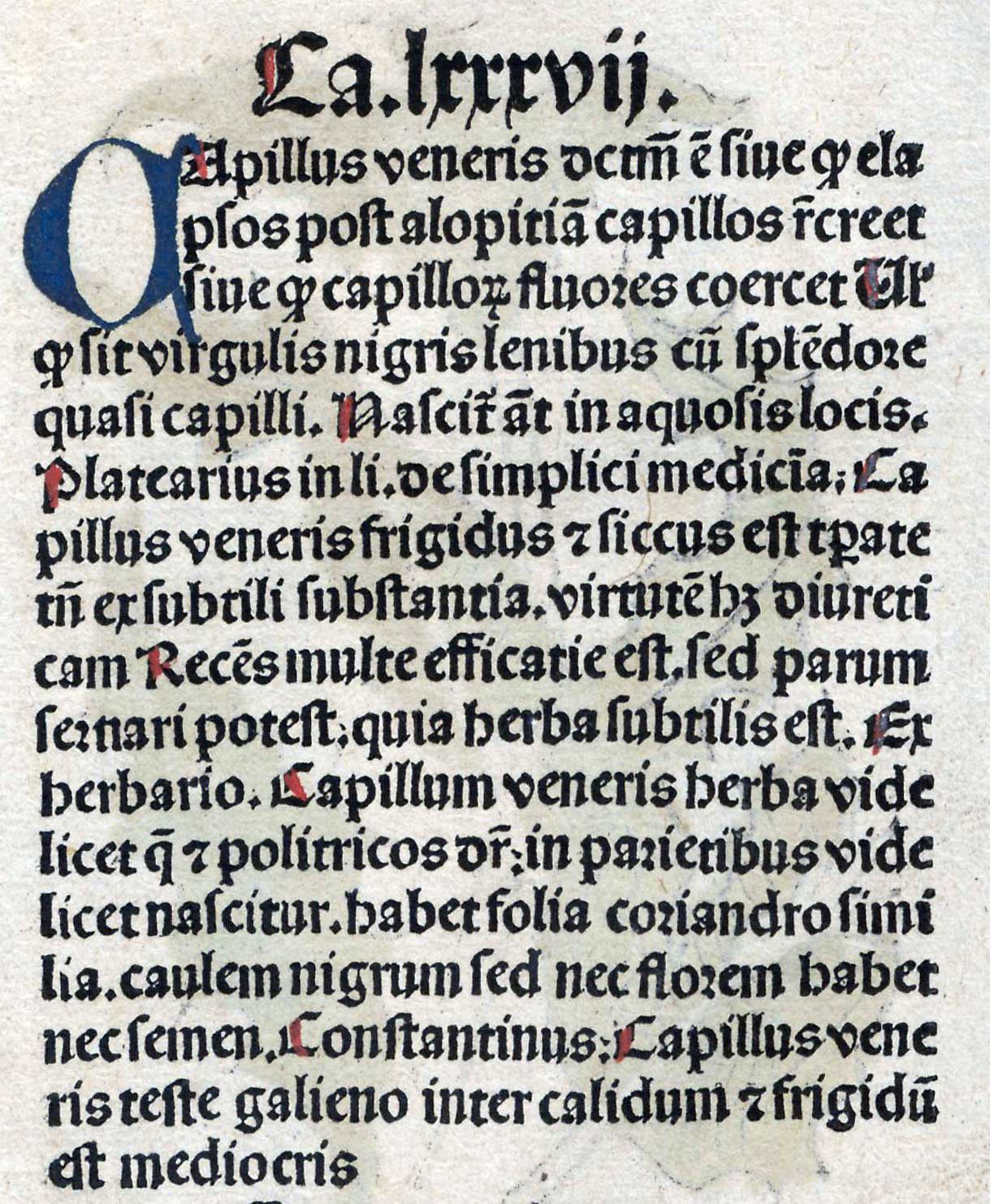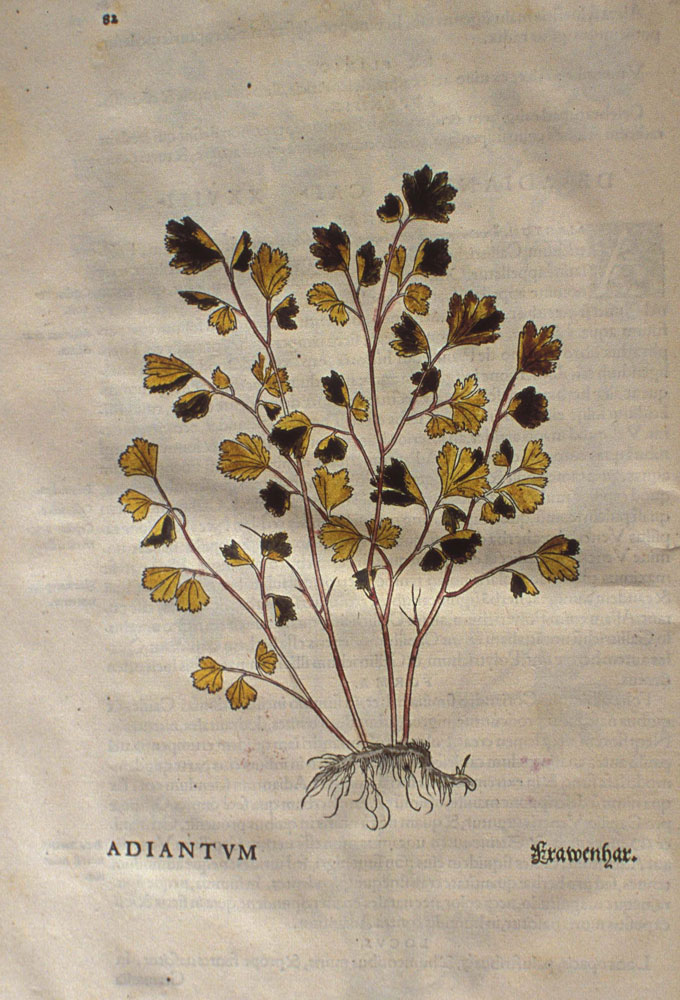Adiantum, because [it] never retains humidity, although it grows near water, and although one plunges it in water for very long time;
Original French: Adiantum: car iamais ne retient humidité, quoy qu’il naiſſe pres les eaues, & quoy qu’on le plongeaſt en eaue par bien long temps:
Modern French: Adiantum: car jamais ne retient humidité, quoy qu’il naisse près les eaues, & quoy qu’on le plongeast en eaue par bien long temps:
Among the plants named for their admirable qualities.
Adiantum is from the Greek meaning “unwetted,” refering to the fronds’ ability to shed water. Delaunay identifies the plant as Adiantum capillus Veneris, L. [1]
1. Rabelais, François (ca. 1483–1553), Oeuvres. Édition critique. Tome Cinquieme: Tiers Livre. Abel Lefranc (1863-1952), editor. Paris: Librairie Ancienne Honoré Champion, 1931. p. 353. Internet Archive
Notes
Capillus Veneris
Capillus Veneris (text)
Adiantum
Taxon: Adiantum capillus-veneris L.
Ancient Greek:adianton
English: Venus’s-hair fern, Southern maidenhair
French: Capillaire cheveux-de-Vénus, Cheveux de Vénus, Capillaire, Chevelure de Vénus, Capillaire de …
German: Frauenhaar, Jungfernhaar, Venushaar
Par bien long temps
Voiez Pline, l. 22. chap 21.
adiantum
Aliud adianto miraculum: aestate viret, bruma non marcescit, aquas respuit, perfusum mersumve sicco simile est—tanta dissociatio deprehenditur—unde et nomen a Graecis alioqui frutici topiario. quidam callitrichon vocant, alii polutrichon, utrumque ab effectu. tinguit enim capillum et ad hoc decoquitur in vino cum semine apii adiecto oleo copiose, ut crispum densumque faciat; et defluere autem prohibet. duo eius genera: candidius et nigrum breviusque. id quod maius est, polytrichon, aliqui trichomanes vocant. utrique ramuli nigro colore nitent, foliis felicis, ex quibus inferiora aspera ac fusca sunt, omnia autem contrariis pediculis densa ex adverso inter se, radix nulla. umbrosas petras parietumque aspergines ac fontium maxime cum aquas non sentiat. calculos e corpore mire pellit frangitque, utique nigrum, qua de causa potius quam quod in saxis nasceretur a nostris saxifragum appellatum crediderim. bibitur e vino quantum terni decerpsere digiti. urinam cient, serpentium et araneorum venenis resistunt, in vino decocti alvum sistunt. capitis dolores corona ex his sedat. contra scolopendrae morsus inlinuntur, crebro auferendi ne perurant, hoc et in alopeciis. strumas discutiunt furfuresque in facie et capitis manantia ulcera. decoctum ex his prodest suspiriosis et iocineri et lieni et felle subfusis et hydropicis. stranguriae inlinuntur et renibus cum absinthio. secundas cient et menstrua. sanguinem sistunt ex aceto aut rubi suco poti. infantes quoque exulcerati perunguntur ex iis cum rosaceo et vino prius. folium in urina pueri inpubis, tritum quidem cum aphronitro et inlitum ventri mulierum ne rugosus fiat praestare dicitur. perdices et gallinaceos pugnaciores fieri putant in cibum eorum additis, pecorique esse utilissimos.
Maidenhair too is remarkable, but in otherMaidenhair. ways. It is green in summer without fading in winter; it rejects water; sprinkled or dipped it is just like a dry plant—so great is the antipathy manifested—whence too comes the name given by the Greeks [bἀδίαντον, “water proof”] to what in other respects is a shrub for ornamental gardens. Some call it lovely hair [καλλίτριχον] or thick hair [πολύτριχον], both names being derived from its properties. For it dyes the hair, for which purpose a decoction is made in wine with celery seed added and plenty of oil, in order to make it grow curly and thick; moreover it prevents hair from falling out. There are two kinds: one is whiter than the other, which is dark and shorter. The larger kind, thick hair, is called by some trichomanes [Mad on hair, i.e. with wild hair (?)]. Both have sprigs of a shiny black, with leaves like those of fern, of which the lower are rough and tawny, but all grow from opposite footstalks, close set and facing each other; there is no root. It is mostly found on shaded rocks, walls wet with spray, especially the grottoes of fountains, and on boulders streaming with water—strange places for a plant that is unaffected by water! It is remarkably good for expelling stones from the bladder, breaking them up, the dark kind does so at any rate. This, I am inclined to believe, is the reason why it is called saxifrage (stone-breaker) [Stones in the bladder are calculi not saxa] rather than because it grows on stones. It is taken in wine, the dose being what can be plucked with three fingers. Diuretic, the maidenhairs [The change to the masculine plural is odd. Perhaps Pliny took callitrichon and polytrichon as masculines. The other alternative is to understand ramuli (see § 63), which Mayhoff thinks has fallen out here] counteract the venom of snakes and spiders; a decoction in wine checks looseness of the bowels; a chaplet made out of them relieves headache. An application of them is good for scolopendra stings, though it must be taken off repeatedly for fear of burns. The same treatment applies to fox-mange also. They disperse scrofulous sores, scurf on the face and running sores on the head. A decoction of them is beneficial for asthma, liver, spleen, violent biliousness and dropsy. With wormwood an application of them is used in strangury and to help the kidneys. They promote the afterbirth and menstruation. Taken in vinegar or blackberry juice they check haemorrhage. Sore places too on babies are treated by an ointment of maidenhair with rose oil, wine being applied first. The leaves steeped in the urine of a boy not yet adolescent, if they be pounded with saltpetre and applied to the abdomen of women, prevent the formation of wrinkles. It is thought that partridges and cockerels become better fighters if maidenhair be added to their food, and it is very good for cattle.
Adiantum
De α privatif et διαινο[?], humecto, madefacio.
Adiantum
Pliny xxii. 21, §30.
adiantum
Adiantum, de α privatif et διαίνω, je mouille, plante qui, trempée dans l’eau, ne s’en imbibe point. «Aquas respuit, perfusum mersumve sicco simile est», dit Pline, XXII, 30. L’Adiantum de Pline, c’est la doradille, Asplenium trichomanes L. Mais ce que Pena et Lobel appelaient Adiantum avec Théophraste, Nicandre et Dioscoride, est A. capillus Veneris, L. On observe à la surface de beaucoup de plantes un revêtement cireux, et même, sur les feuilles de certaines fougères, un saupoudrage de véritable matière rasse, qui les imperméabilise. (Paul Delaunay)
par les admirables qualitez
Cf. encore, De latinis nominibus pour tous ces détails. Le seule exemple qui ne s’explique pas de soi-même est hieracia; «Hieracum nomen ex eo venit quod [l’epevier] succo hujus herbae oculorum obscuritatem discutiant». Eryngion (« barbe à bouc ») serait un contrepoison. Que-fait-il dans cette liste?
Adiantum
De α- privatif et διαίνω, «mouiller», doradille; (Pline, XXII, xxx).
Adiantum
Adiantum. [Latin, adaptation of Greek a’di´anton maiden-hair, `unwetted’, formed on a’ not + diai´n-ein to wet; so called from the way in which the surfaces of the fronds resist wetting.]
A genus of ferns, having more or less wedge-shape pinnules on slender black shining stems, and marginal sori, covered by distinct indusia, of which one species (A. Capillus Veneris), commonly called True Maiden-hair, is a rare native of Britain.
1706 Phillips, Adiantum, The Herb Maiden-Hair, so call’d because its Leaves take no wet.


